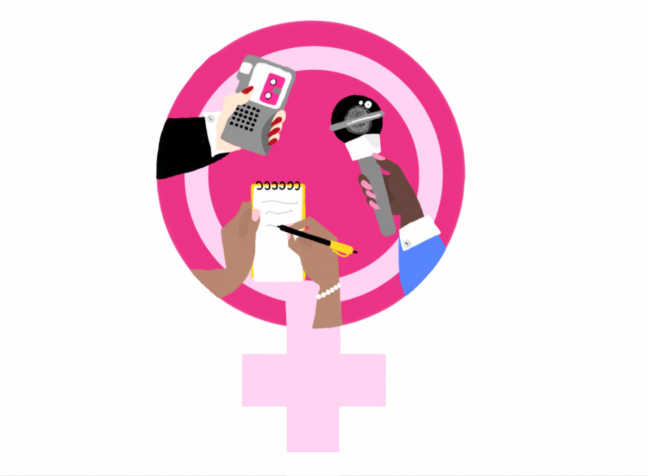Take a look at the masthead of The Badger Herald or the attendance roster for many journalism classes at the University of Wisconsin — the names and faces that make up those lists are predominantly female. According to the UW Spring Enrollment report, the UW School of Journalism and Mass Communication is a whopping 78% female.
In fact, it’s more common in the United States for women to have a degree in journalism than it is for men, with 67.7% of the people in the U.S. with a journalism degree being women, according to Data USA.
But the makeup of the journalism workforce tells a different story. The Women’s Media Center report, “The Status of Women in the Media in 2017”, noted men have received 84% of the last century’s Pulitzer Prizes. Sixty-two percent of all bylines and other credit in print, television, wire and digital news also belong to men.
While the number of female reporters is rising, in 2018, women made up only a little over one third of newsroom employees in the U.S. — and this number only decreases for women of color, according to the American Society of News Editors’ Diversity Survey.
This small amount of progress took many years to come about.
(Her)story of Women in Journalism
Assistant Professor in the UW School of Journalism and Mass Communication Kathryn McGarr has seen this trend throughout her work.
“The J-School in Madison is overwhelmingly women, and I think there is a larger trend of more women in journalism programs,” McGarr said. “But then unfortunately, there’s been less and less women who are in the profession, and then fewer women reporters, and then even fewer women editors and managers. So as you go up the ladder, you get fewer and fewer women in positions of power.”
McGarr’s research focuses on reporters in Washington, D.C., in the 1940s and 50s who wrote about foreign policy and their social and professional networks.
And while McGarr said a lot has changed for female journalists since the 1950s, the lack of female journalists can be traced back to men actively trying to keep women out of reporting during that time period.
“I think one of the things that surprised me most, at least in Washington journalism, was how actively men reporters kept women from being reporters,” McGarr said. “There were a lot of women who were reporters, but for example, they couldn’t really cover the foreign policy beat because they weren’t allowed in the spaces where those conversations were happening.”
Exclusion was a common theme in journalism throughout the 1950s and 60s because though women could be hired at major newspapers, they were not allowed in many of the spaces that men were, McGarr said.
And this exclusion of female journalists went on well into the 1970s, McGarr said, until women at the New York Times, as well as at Newsweek, filed Equal Employment Opportunity Commission complaints under Title VII of the Civil Rights Act.
“So the 1970s was this watershed moment where there had been this problem, and women had recognized that it was a problem, and it sort of took this federal intervention for anything to be done about it,” McGarr said.
But McGarr said since the 1970s, the work environment has improved for female journalists.
“It certainly has gotten a lot better — it is not perfect, of course, and there is still kind of a male-dominated culture that goes with it,” McGarr said. “But, nothing like it was before that period.”
Slow Improvement
Editor-in-Chief of the Daily Cardinal, another UW student newspaper, Robyn Cawley also believes things are changing in journalism with more female reporters entering the workforce than ever. Cawley said she has seen this in the Cardinal’s predominantly female office.
“I do think that our paper is very, like feminine and very female run,” Cawley said. “The past two management teams [we have had] have been both female. And I think doors are opening for more conversations, and it feels more natural [to have] women running this office and being present in the office.”
Board Chair for The Badger Herald Peyton David has also seen this change in their newsroom, as there has been “a matriarchy,” for many years at the paper. Former staffer at the Herald and current reporter at The Wisconsin State Journal Emily Hamer also saw this trend in her time with the Herald.
“I think everybody who worked at the Badger Herald — or the vast majority of the people who worked at the Badger Herald — on our staff were women,” Hamer said.
But McGarr believes this observation could simply be part of the larger trend in the U.S. of women getting degrees in journalism, but not becoming reporters.
In fact, Hamer said when she started working at the Wisconsin State Journal, she was surprised with the amount of men in the office.
“I think most of the older reporters in the Wisconsin State Journal newsroom are men, and it was just — I was used to being sort of surrounded by women at the Herald,” Hamer said. “And I had never really thought about journalism as a male-dominated field before but I was like, wow, okay. There are a ton of older men in this field.”
Opinion Editor and former State Politics and Government reporter at the Madison Capital Times Jessie Opoien agrees that the journalism field is still dominated by men. But, in her time at the Cap Times, Opoien said she has seen this start to change.
“[Journalism] is absolutely a male-dominated field, as it has been traditionally, for a long time,” Opoien said. “But that being said, I work with a lot of really great women. And I think that I’ve seen that change. Even in the time that I’ve been doing this, which has only been like 10 years, but I do see a lot more younger women coming up and a lot of a lot of women kind of rising quickly into positions that are really prominent.”
Barriers in 2020
Though there has been this change, there are definitely less women in certain beats, Opoien said, particularly in state politics. Current State Politics and Government reporter at the Capital Times Briana Reilly echoed this, stating politics in general is still very male-dominated.
Reilly said covering a beat that involves more men than women presents a challenge for her, as she can see how there are advantages to being a man covering the Capitol building.
“But I think, given the fact that the legislature is pretty male-dominated as well, I think there could be an advantage to being a man covering the building in the sense that there might be more of a willingness to, you know, chat with another man … so I wouldn’t say that I’m at a disadvantage,” Reilly said. “But, I would say that I felt the need to be working constantly so that I can do the best that I can under whatever circumstances I’m in.”
Reilly said she also approaches interviewing and networking differently as a woman than she has seen her male colleagues do, making sure to draw strict lines between what is work-related and what is more friendly.
Opoien agreed with this, emphasizing how important it is to let sources know meetings are strictly work-related, as networking meetings can get “too personal.”
“Often you know, you might be at a networking meeting or a source meeting having drinks, and it ends up getting, like way more personal than you expected them to be,” Opoien said. “There is definitely a difference in that experience and the [male journalists] that I talk to are usually really surprised to hear about the stuff that’s pretty commonplace for women.”
Hamer often reports on criminal justice, and has had similar experiences with inmates crossing the line and getting too personal with her. She also added that sometimes it seems men don’t take female reporters as seriously as male reporters. But, Hamer said she has been in many circumstances where it seems sources feel better talking to her because she is a woman.
“So I feel like sometimes sources can be more comfortable with women and be more vulnerable with women and that’s an advantage,” Hamer said. “But having to worry about getting hit on is not ideal.”
Sexual harassment is also commonplace in journalism for women, McGarr said. According to the International Women’s Media Foundation, 70% of female journalists experience more than one type of harassment, threat or attack in the past, and 52% have experienced an offense within the past year.
Reilly said the amount of sexism and sexual harassment she has heard of in the journalism industry really surprised her, and often female journalists don’t know how to handle it.
McGarr added that this harassment has only gotten worse in the digital age, with journalists being more available on social media.
“I think one of the main differences in the experience of women and men journalists is how they get treated by readers and colleagues,” McGarr said. “And you get a lot more slack, especially online on Twitter, for being a woman journalist. That was something I never had to deal with, but I know that it is an experience that is very common.”
An Important Angle
Despite the obstacles for female journalists, Opoien said, it is still extremely important for women to go into the journalism field, as they bring a unique angle to stories that men don’t.
“As a woman in journalism, I think a lot about how to maximize the diversity of my sources and make sure that I’m talking to women and I’m talking to people of color and people who look like the population of our community,” Opoien said. “And I think that’s probably something that is more thought of by women and by journalists of color, and by people who aren’t used to seeing themselves represented in the media.”
Cawley agreed with Opoien in that women allow for more inclusive stories to be told, but having women in the workforce is only a small step for a completely equal playing field.
“I think having [women in journalism] shows that progress is being made. But more progress needs to happen,” Cawley said.















